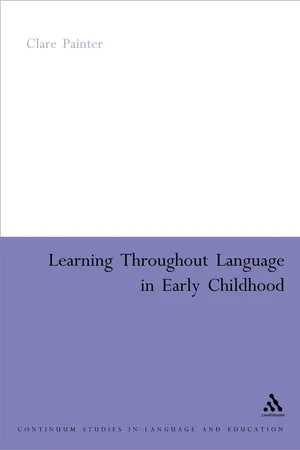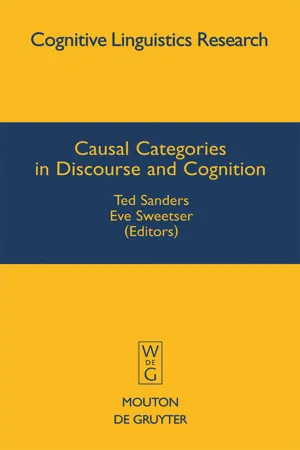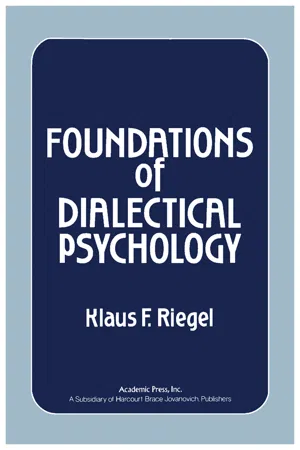Languages & Linguistics
Causal Relationships
Causal relationships refer to the cause-and-effect connections between events or phenomena. In linguistics, causal relationships can be observed between language use and social, cultural, or psychological factors. Understanding these relationships can help explain language variation and change.
Written by Perlego with AI-assistance
Related key terms
1 of 5
5 Key excerpts on "Causal Relationships"
- eBook - PDF
- Clare Painter(Author)
- 2005(Publication Date)
- Continuum(Publisher)
6 Cause-effect relations The preceding three chapters have presented a case study of learning through language, attending to the construal of taxonomic relations and of material and semiotic activities respectively. The focus has therefore been on the texts which have mobilized language to address the problems of 'making sense' of each of these realms of experience. In this chapter, the analytical lens will be readjusted a little so as to focus directly on the development of one of the meaning systems through which learning is achieved across the different domains -that of causal relations. The purpose of this is twofold. On the one hand it will enable a closer consideration of the development of language as system. On the other hand, it will provide a context for revisiting some of the data already presented, together with further material, to illustrate the child's growing ability to learn by engaging in the semantic process of reasoning. Causal relations have been chosen for particular attention, both because they have entered the description of all the previous chapters and because of their theoretical prominence within cognitive approaches to learning. The ability to infer cause—effect relations is fundamental to notions of 'logical' or 'scientific' thinking, and the fostering of the abilities to reason and hypothesize are prominent educational goals throughout the Western world. In particular, these matters have received considerable attention within the Piagetian developmental framework, where the ability to formulate alternative hypotheses, test them and draw relevant conclusions is seen as the hallmark of the highest stage of cognitive development, that of 'formal operations'. i Developmental background Piaget's observations that it was not until 7 or 8 years of age that children could distinguish causes and effects in their speech have been the source of considerable research and experiment over the years. - eBook - PDF
- Ted Sanders, Eve Sweetser, Ted Sanders, Eve Sweetser(Authors)
- 2009(Publication Date)
- De Gruyter Mouton(Publisher)
This could lead us to expect that cross-culturally, there will be some important contrasts between causal categories, which are part of a universal repertory potentially named by any language. Such a view would be similar to many analyses of color terms – it is not the case that every language must name every human visual color distinction, but rather that color vision provides a universal perceptual basis for the range of possible linguistic categories. Language users often systematically prefer one lexical item rather than an-other (even highly similar) one to express a certain type of causal relationship. Such choices could provide a window on speakers’ cognitive categorizations of causality. Studies of the linguistic categories apparent in people’s everyday lan- 2 Ted Sanders and Eve Sweetser guage use have already produced many interesting insights into the working of the mind in other domains (see, for instance, Lakoff 1987; Lakoff and Johnson 1999). The linguistic study of the meaning and use of causal connectives and auxiliaries may reveal insights into human categorization of causality. Sweetser (1990) introduced the categories of content , epistemic and speech act use of causal conjunctions like because and since are illustrated in (1) – (3). (1) John came back because he loved her. (i.e. the loving caused the return) (2) The neighbors are not at home because the lights are out. (i.e. the observation that the lights are out causes the conclusion that the neighbors are away) (3) Since you’re so smart, when was George Washington born? (i.e. the question is presumed to be motivated or enabled by the ad-dressee’s claim to superior intelligence) Similar distinctions have been dominant in many existing classifications of coherence relations – meaning relations that exist between discourse segments, e.g. - Johannes Dellert(Author)
- 2019(Publication Date)
- Language Science Press(Publisher)
2 Foundations: Historical linguistics Te purpose of this chapter is to give readers with a causal inference background sufcient knowledge o f historical linguistics to arrive at a basic understanding of the new application domain. For readers with a linguistics background, it may serve as a quick overview of the relevant core de fnitions and issues o f historical linguistics as I am framing them for the purpose of my work, sometimes deviating a litle from the established terminology. Te second half of the chapter is of more interest to the linguist reader. It gives a rough overview of existing computational approaches to modeling language history, and discusses the current state of the art in reference to the methods of classical historical linguistics. For the exposition, I need to presuppose some basic knowledge of phonology, or the sounds occurring in spoken languages. I will normally represent sounds by means of the IPA (International Phonetic Alphabet), which has become the standard across all branches of linguistics. To learn what these symbols represent, I recommend Ladefoged & Maddieson (1996), the standard textbook of phonology. For readers who are not interested in languages and their pronunciation, but merely want to understand the methods I am developing and describing here, it should also be possible to follow the discussion by treating the IPA as a bag of elementary symbols (an alphabet in the formal sense), and not assigning any meaning or properties to them. 2.1 Language relationship and family trees While very encompassing defnitions o f language can be given, at the core, a language such as English or Spanish can be seen as a system of symbols (vo-cabulary) and combination rules (grammar) used for communication.- eBook - PDF
- Klaus F. Riegel(Author)
- 2013(Publication Date)
- Academic Press(Publisher)
The Relational Basis of Language Psychologists studying language commonly regard defining the elements of an analysis as one of their most important tasks. Many settle quickly on words or syllables as basic units, if not on the infamous non-sense syllable. T o linguists, however, words as well as syllables pose grave problems, and they have devoted tedious treatises to their analysis. T h e scholarly superiority of linguists is only superficial, however. If they do nothing else but choose different, although more sophisticated, elements for their analysis, such as morphemes or phonemes, they fail to over-come such particle models of language. Of course, once these units have been defined, the scientists will proceed to explain how they are ar-ranged into larger sequences. In psychology, associations have tra-ditionally provided the necessary bonds, and it was hoped that eventu-ally science would be able to reconstruct the complexity of h u m a n ex-perience. While in all these efforts elements were regarded as prior to their connections, I will argue for the priority of relations over ele-ments. Such a shift in interpretation represents a renewed emphasis on the language users and on common, meaningful, phenomenal ex-perience. Extralingual Relations Exchanged information consists of connected and never of isolated terms. Thus, if we explain the word ZEBRA to a child, we say (A) zebra (has) stripes or (A) zebra (is an) animal and even if we use nothing but the word ZEBRA we, most likely, point to a real zebra or to the picture of one. T h u s we are invoking a special extralingual relation between a label and the object denoted by it, which I will call ostensive relations. O n some other occasions, we may utter single words like G O or STOP, expecting that the child will perform the requested actions. T h e role of commands and demands has received considerable attention in studies 70 - eBook - PDF
Mouton Classics
From Syntax to Cognition. From Phonology to Text
- (Author)
- 2013(Publication Date)
- De Gruyter Mouton(Publisher)
We assume that language is a good source of evidence for discover-ing at least some of the conceptual structures associated with causation. We will not attempt here to justify the structures we posit with evidence from non-linguistic domains, although we recognize that such additional justification is highly desirable. In the course of this paper, we suggest that causative structures relate to specific cognitive models (Lakoff 1987 and elsewhere), which represent integrated conceptual structures with specifiable properties. Returning now to the linguistic expression of causation, we wish to further delimit the ränge of structures we are interested in. It is not the case that all constructions expressing two events viewed as causally related fall under our definition of causative constructions. (Event here includes action, process and State predicates.) Expressions such as They insulted me, so I left are excluded, even though they contain two predicates with a causal relation between them. The hallmark of the causative construction, which sets it apart from the latter kind of expression, is that in the causative construction the actual causing event is not overtly specified by one of the predicates. All that is expressed by the predicate representing the causing event, which we will call the causal predicate, is the pure notion of cause (or the closely related one of enablement; cf. below), without more specific lexical content. (Contrast INSULT in the above example, which describes what type of event caused the leaving.) This necessarily means that the causal predicate is conceptually dependent 454 Suzanne Kemmer and Arie Verhagen [118] on the effected predicate; in other words, causal predicates necessarily evoke the idea of another action or State.
Index pages curate the most relevant extracts from our library of academic textbooks. They’ve been created using an in-house natural language model (NLM), each adding context and meaning to key research topics.




